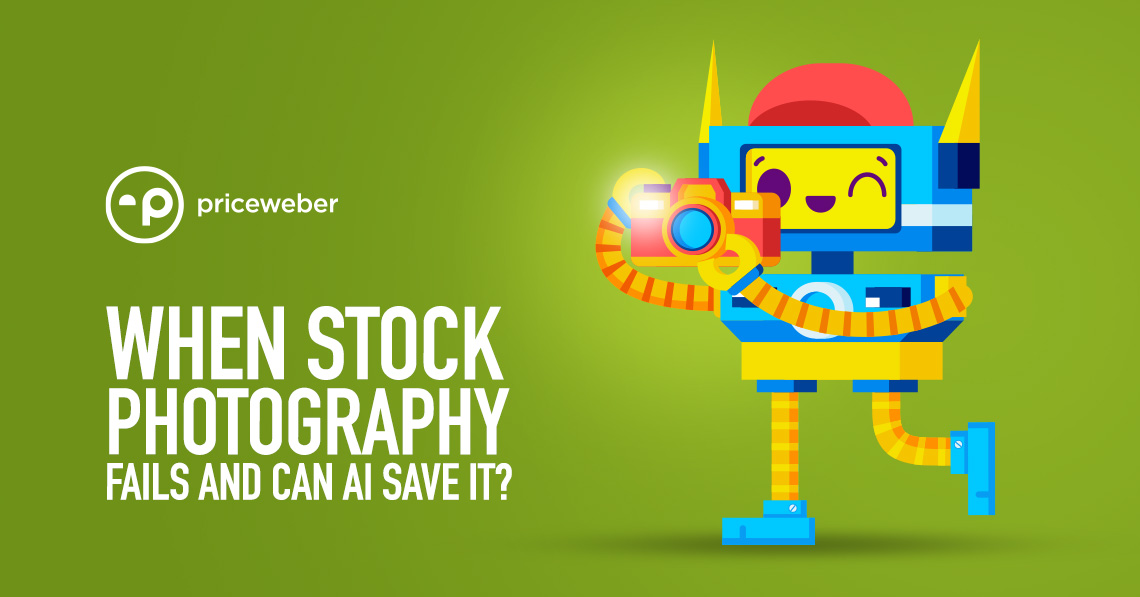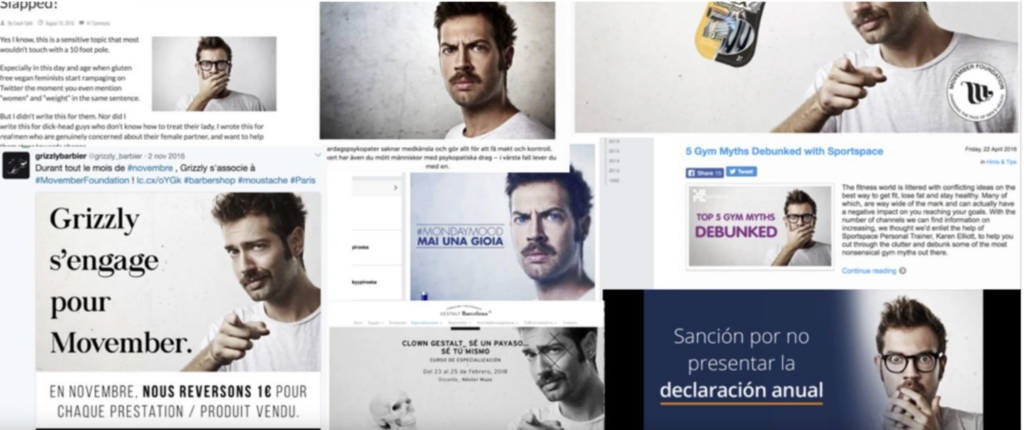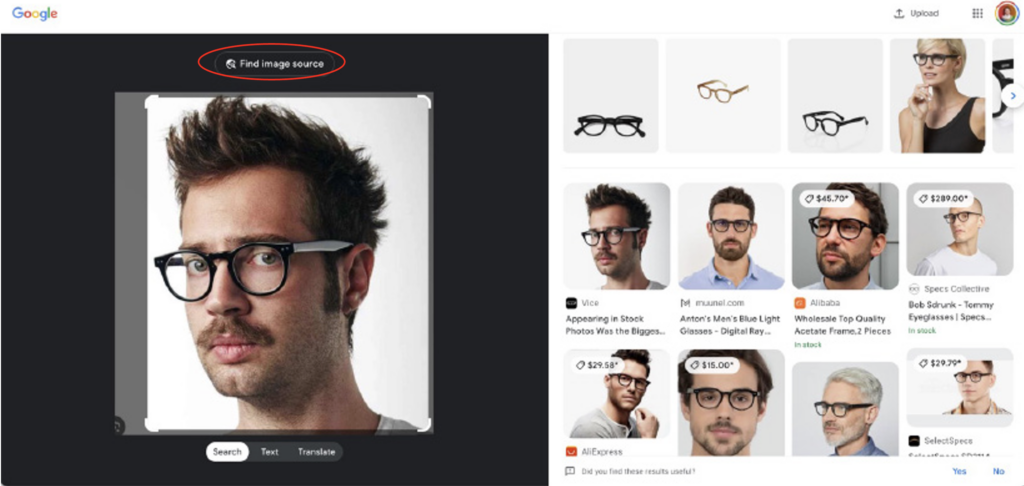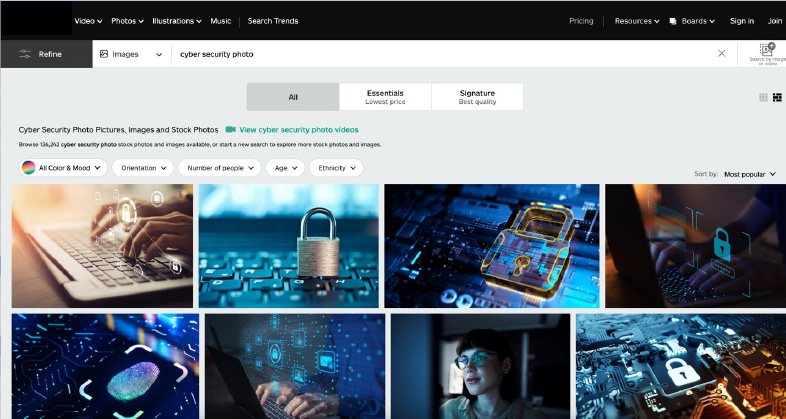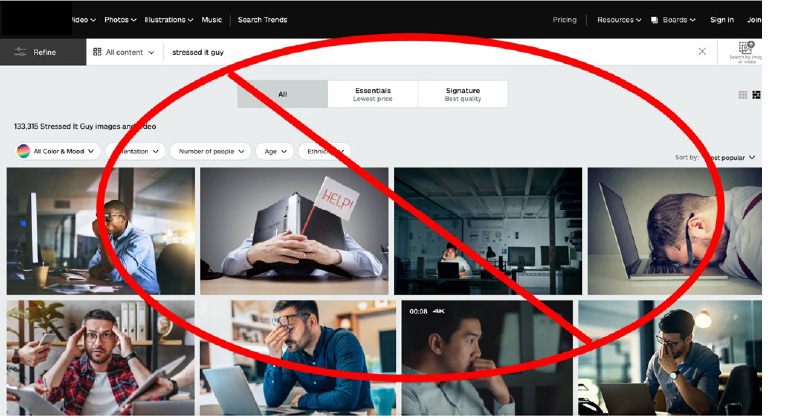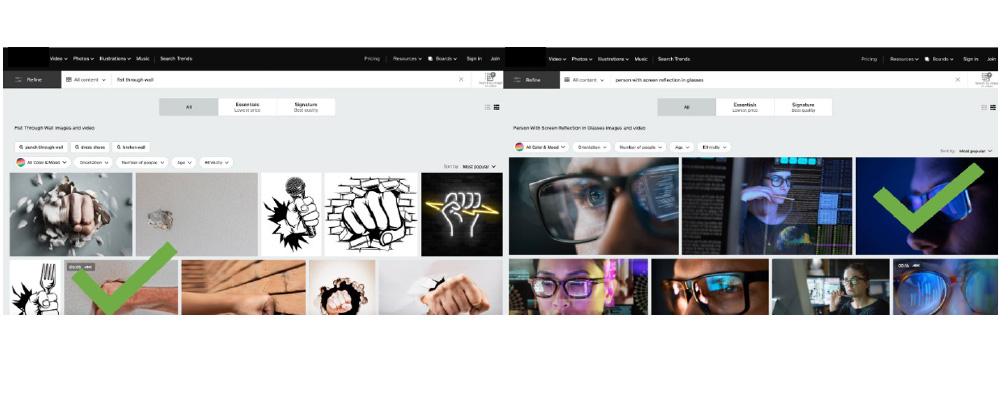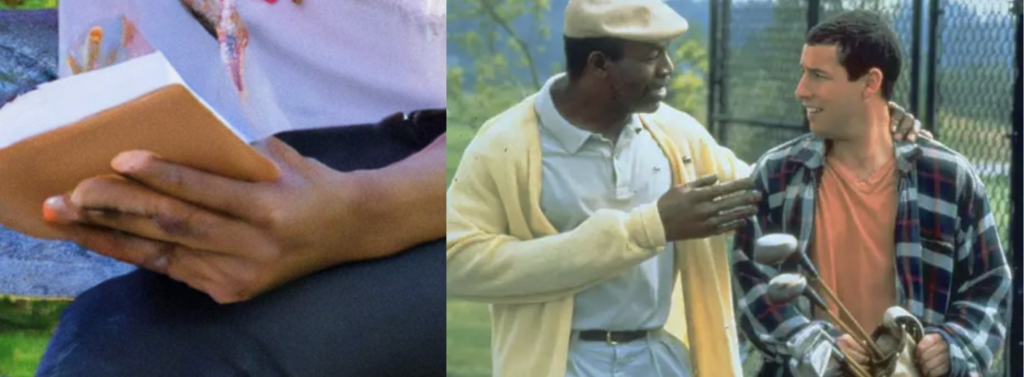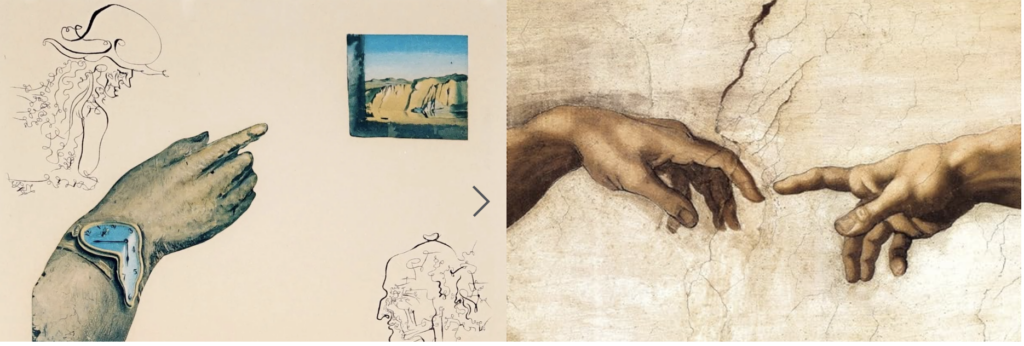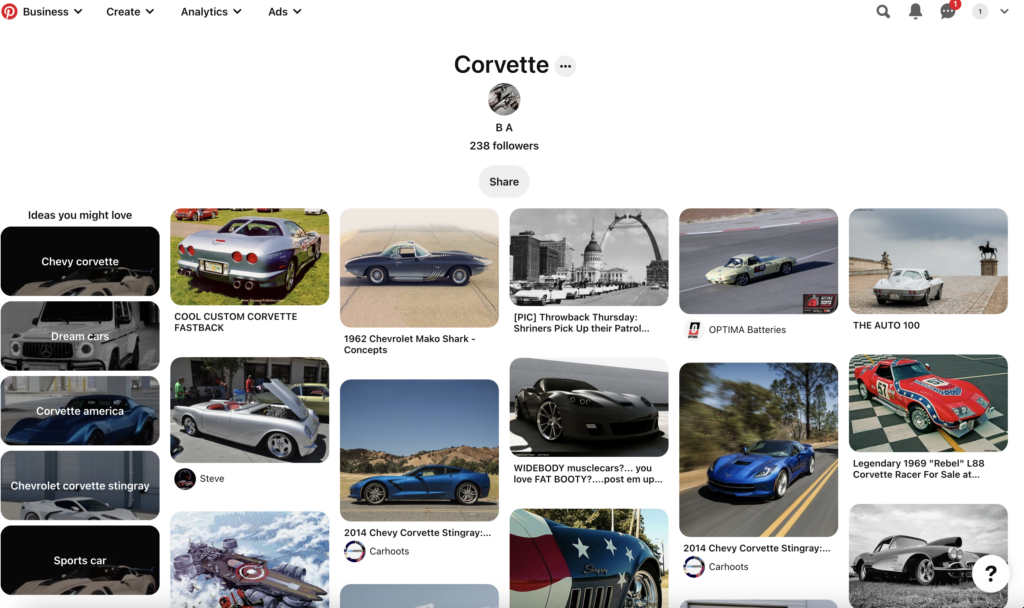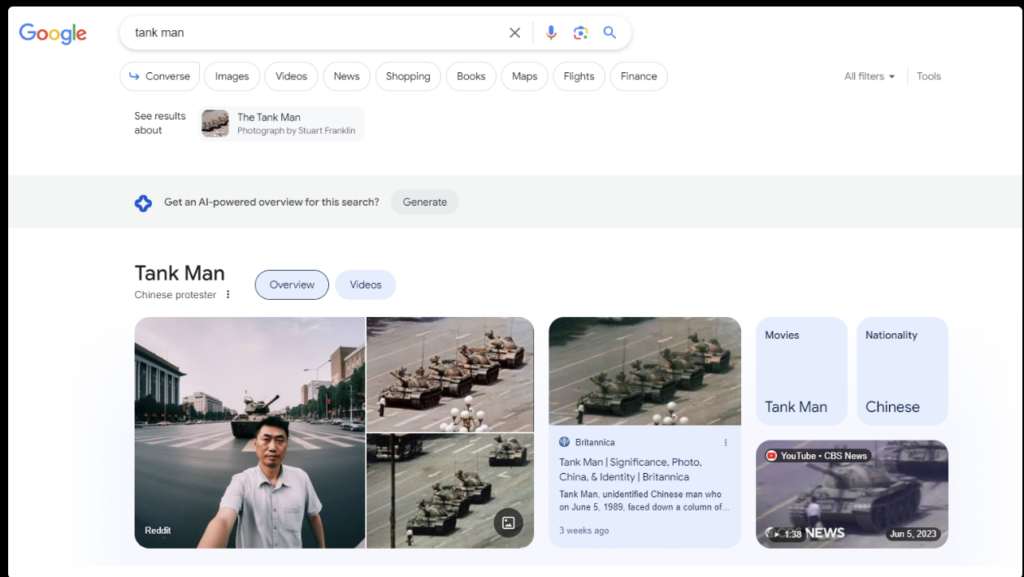Recently, we onboarded a new client with a rapidly growing technology company. The company needed help in several areas, but most importantly, they needed a new website. In reviewing their current website, we noticed a stock photo we laughed about because we were certain we’d seen it many times before. After a quick Google Images search, we found the same image on hundreds of similar and competitive websites.
Understanding that even the biggest of brands can, at times, rely on stock photography, in this edition of Plain Talk, we’ll look at the two factors that lead to most stock photography fails. Plus, we’ll discuss how to best avoid stock photography and how to best maintain brand authenticity when stock is your only choice. Then, we’ll look at the present state of AI as an alternative.
1. Same model, different diagnosis!
If you’re old enough, you probably remember the episode of “Friends” where Joey modeled for a stock photography company and ended up being used in STD awareness poster ads throughout New York City subway stations. While this funny episode put a damper on Joey’s dating life, the concern for models in stock photography is real, particularly in healthcare. It’s not just Joey! The stock photo model you choose for your ad may not just be chosen by your competitor but may even be for a company, service or syndrome that hurts your brand.
In 2008, AdWeek wrote an article about “Everywhere Girl” – Jennifer Anderson. After doing just one photo shoot in 1996 as a college student, her pictures have appeared on over 80 book covers, countless thousands of ads and even billboards in at least four southern states!
But she’s not alone. Niccolò Massariello penned an article in Vice in 2017 about his experience. At a particular low point in his life he agreed to a single-day stock photo shoot. A year later, he was the post-person for everything from Those Catholic Men to gluten-free horchata to a “horrifying penis condition” called paraphimosis!
While most stock photography models aren’t as popular as “Everywhere Girl” or Niccolò, there’s a good chance that the stock image you chose has made its way around. You can do a Google Images search for an image, but it’s far from full proof.
When we did a Google Images search for Niccolò, Google focused on his glasses and delivered images of people wearing his same frames.
By clicking “Find image source,” we found 17 places on the internet using this exact image of Niccolò. It also intermittently salted in similar images of other people, but it did not find any of the other Niccolò poses from his photo shoot!
Also, it seems the latest AI facial recognition software isn’t readily available to the general public yet. Multiple searches for the same image of Niccolò using a popular subscription facial recognition search platform netted results numbering from 29-43. That’s a lot of Niccolò variance!
But even if your less popular stock photography model seems safe for now, there is no guarantee that they will stay that way unless you buy exclusive rights, which may end up costing more than a photo shoot.
2. Nothing says cybersecurity like a padlock on a keyboard!
Let’s be honest: stock photography photobanks are packed full of these stupid cliché images. These clichés are rushed and lazy, talentless execution.
A 15-second search on one popular royalty-free photo site for “cyber security” yields the padlock as the second image. It’s no wonder it’s been perpetuated so heavily across the web on so many low-budget and not-so-low-budget websites. It requires no creative thinking.
In fact, this image isn’t alone. There are dozens of articles, posts and pages dedicated to calling out overused stock photo images and image types such as the handshake, the attractive call-center person wearing a headset, the seedling in hand, the dartboard bullseye, the chess board, the stressed-out IT guy, the jumping people in suits and more!
These images perpetuate because users are searching for images without a vision or a concept for what they are trying to communicate. Instead, they are just searching for keywords in the copy: meet, give us a call, grow, on-target, strategic, or stressed IT guy. You could even argue in these scenarios that the stock photography company is functioning as the “creative director,” and these designers are just executing the layouts! And why not? Aren’t they relinquishing the thinking to the search algorithm?
How to avoid stock photography
Obviously, avoidance is the best solution, but that requires expensive photo shoots, right? Well, to quote a paid consultant, “Yes and no!”
Yes, photo shoots are, in general, more expensive and more time-consuming than using a stock image, but if you can plan the year, you can often group many projects or needs for a brand together, execute your own photo shoot and cost-effectively build your brand better. For example, a few years ago we were developing materials for “owner-operators” (truck drivers who own their own trucks) for a client. The campaign called for close-up photos of drivers, and it was challenging to find stock photo images of people who were believable as truck drivers. Halfway through the campaign, we convinced the client to allow us to send photographers to a tradeshow and photograph real truckers who were fans of our client’s brand. The move not only improved the campaign, but it was also extremely cost-effective, requiring only one day of shooting. So, the first way to avoid stock photography is through planning.
The second way to avoid stock photography is through substitution. This is especially effective for websites and presentations. Does the visual of the hands holding the seedling really add to your message? Can you do without? Or is there a graph or chart from the annual report that speaks to growth more authentically? Often, as designers, we find ourselves adding an image correctly just to create a visual break in text. Those visual breaks can often be achieved through charts or other existing assets.
In the case of the need for visual breaks, design elements can also be used as a third alternative to cliché or overused stock .
When you can’t avoid them, use them wisely
The best way to not contribute to the next “Everywhere Girl” is to thoroughly search your options for a stock model that works for you. Then, once you’ve found an image that you like, click similar images in the stock library. You can usually find four or more images from the same photo shoot of the same model. Some stock services offer help so you can find a unique (read, not overused) image for your project, so if you are stuck, make sure you check with your stock service to see if they can help.
If that’s not an option, do a Google or subscription image search on your chosen images. This will give you a much better understanding of your chosen model’s existing footprint in the world than a single image search.
Another consideration is that when seeking an image, have a concept. For example, instead of just searching for a “stressed IT guy” image, think about how that might be depicted differently. On an extreme end, maybe it’s a hand punching a wall. On a less extreme end, maybe it’s the stern look on someone’s face with their computer screen reflecting in their glasses. Having an idea keeps you from ending up with melodramatic, overacted, overused images that scream both bad stock photography and bad design! Well, maybe not if you’re advertising for Excedrin.
If you don’t have an idea in mind, search for synonyms for the keyword or expression you are looking to express. Searches for “tired” or “angry” may provide less cliché and less used images than “stressed.”
3. What about AI?
Artificial Intelligence is a work in progress and will be an excellent future solution, but for now, let’s deal with the now! There are three issues with AI:
Hands! AI is not Michelangelo yet!
Having read an article about hands not looking right from AI, we did a search for “Attractive African American Woman Reading Book on Park Bench.” This is what we thought the other article author had searched to find her image. Using Open AI’s DALL-E 2, we got back the below four options.
Likewise, their hands don’t look right, but there are other issues as well. Looking closer at each image, they almost seem alien. Picture 1’s legs and torso don’t align, and her left arm is weirdly wavy. She may not have a right elbow. Her nose has two ridges, and neither one of her hands looks like she got an A-grade in shop class!
Think Carl Weathers’ character, Chubbs, with the wooden hand from “Happy Gilmore.”
Taking this one step further to stay in theme with our article, we did a second search for “Person who looks like Niccolò Massariello sitting on a park bench reading a book.”
This resulting image looks more like the alien Roger from the animated series “American Dad” in disguise than Niccolò … even the hands!
The other three options are pretty hard misses too and are best not looked at too closely
Hands … maybe that’s why they named it DALL-E (Dali) and not Michelangelo! LOL
Small pictures of inanimate objects are probably fine. Searching for “Subaru driving through hills in fall” provided these images. While they aren’t billboard quality, if you keep them small, they probably have no blaring visual issues.
Pesky lawyers and intellectual properties!
Can you get sued for using AI-generated images? Probably! In a recent Silicone Republic article, Jonathan Løw of JumpStory says the legal risk may fall on the end user if their AI-generated image enters a copyright dispute.
The article goes on to state how DALL-E is working to eradicate its copyright infringements but that the issues are real. DALL-E 2 is trained on around 650 million images. 12 million of these images were analyzed, and around 47% were sourced from only 100 sources! Further, 8.5% came from Pinterest!
Pinterest is protected by the Digital Millennium Copyright Act (DMCA) of December 1998 as a pinning site, and if the pinned image is properly licensed or the original source, Pinterest has not infringed on a copyright. So, the fact that 8.5% of the trained images are from pinned images from Pinterest should be extremely concerning to you.
Where’s Google going?
Google has not made a definitive decision on AI-generated content; however, Google recommends but does not require that AI-generated images be labeled using IPTC image data metadata. DALL-E and other text-to-image models are moving to automate this into their metadata as part of image origination. At a conference in Japan in May 2023, Google noted that “Their algorithms and signals are based on human content and because of that (they) will rank natural content at the top (of the SERP).”
Google is committed to its E-E-A-T Principle which stands for Experience, Expertise, Authoritativeness and Trustworthiness. As in the case of BERT and countless other algorithm changes over the years, Google is interested in providing the best results for the end user, and they don’t care about your business that much.
To make matters worse, Google recently got egg in their face and had to redact an AI-generated selfie of the Chinese protester run over by the tank in Tiananmen Square after they picked it up from Reddit, and 404 Media called them out in an article, mocking them for not blocking AI-generated images. If incidents like this continue to happen, it would not be surprising for Google to change its stance on AI-generated images solely on the basis of E-E-A-T Principle.
If there’s just one thing reading Ray Kurzweil has taught us, it’s that the technology evolution curve is exponential, not linear, so we imagine a year or two from now, when people read this article, these issues will be fixed, and corrected. This means both the hands+ issues and copyright issues will be resolved. Adopting the “If you can’t beat them, join them!” philosophy, big stock photography companies are figuring out ways to participate and profit from AI-generated images. So long as Google doesn’t find it necessary to identify and exclude content with AI images, AI-generated images may evolve into a good alternative to stock photography. Having just previewed the solution Getty Images and NVIDIA developed, it looks like the hands and intellectual properties issues maybe resolved!
In the interim, AI-generated images make concepting and the design layout faster and easier. Creatives can rough out dozens of concepts quickly and efficiently using AI, saving time and money. AI-generated images can be roughed into designs before the photo shoot is commissioned.
At the end of the day, we want to produce effective, on-brand, on-budget concepts, websites, and campaign materials, but we also want the end user not to automatically know when we’ve used one or all stock images. The purpose of well-placed stock images or soon AI-generated images is to replace the need for original photography at a fraction of the cost. Original photography, is and for the immediate future, going to provide the best, safest solution, so through careful planning, original can often be executed cost-effectively. When it can’t, by approaching the stock libraries carefully and deliberately, we can avoid propagating more “Everywhere Girls” and clichés onto our brands!
If you have questions or just want to share a particularly bad stock image, we’d love to hear from you. Feel free to send us a message or give us a call at (502) 499-4209.

